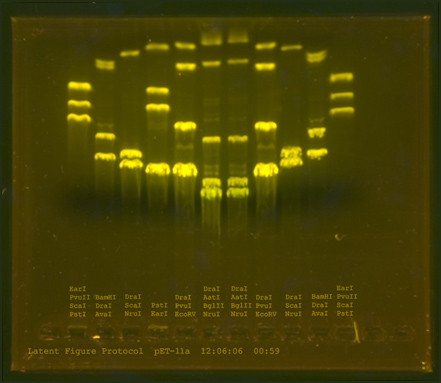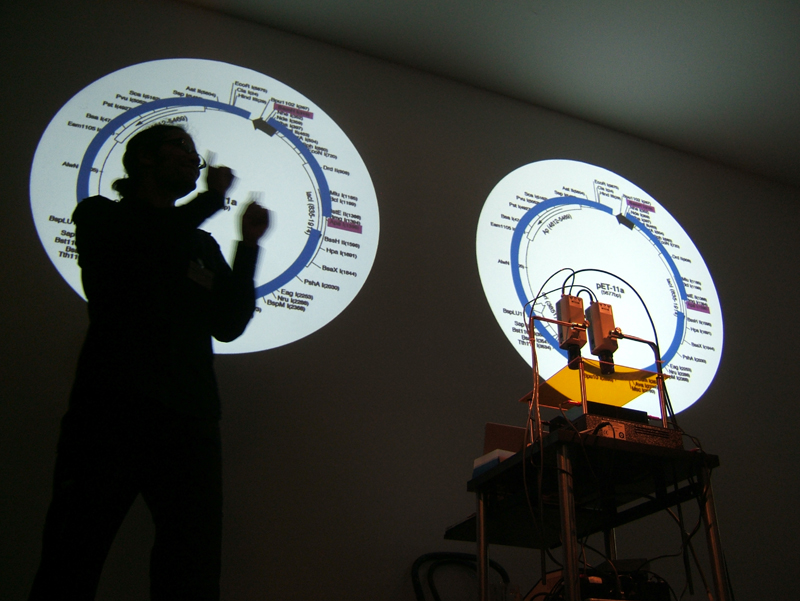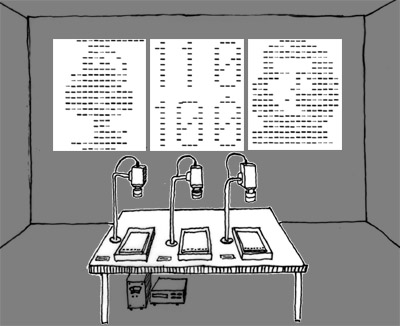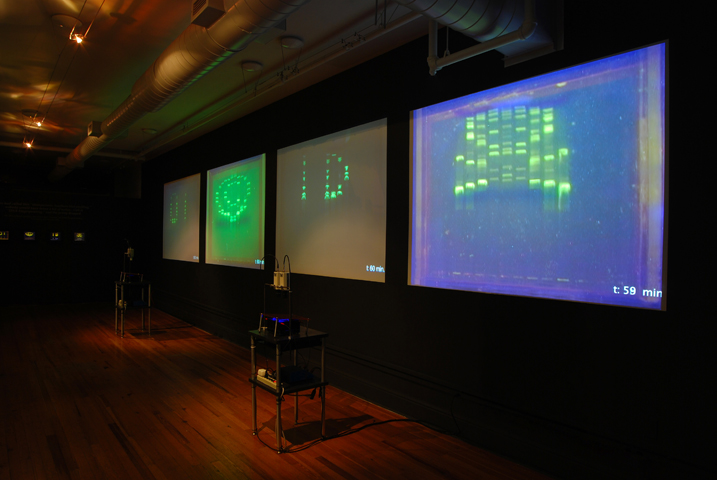
Paul Vanouse's “Latent Figure Protocol" was produced with the DNA of bacterial plasmid pET-11a. Enzymes used to process the DNA are listed in each column. Image produced December 06, 2006. Courtesy of the artist.
The most exciting moments of the intersection of art and science, for me, are when artists’ use of scientific materials and methods reveal new aspects of their media. Genetic evidence is becoming increasingly important in both winning and overturning criminal convictions, yet the methods used to produce this evidence have been found to be inconsistent and subject to error and manipulation. In Paul Vanouse’s Latent Figure Protocol (2007), artistic self-reflexivity is transformed into an imminent critique of the methods of DNA fingerprinting. While such fingerprinting is conventionally used to create an image that uniquely identifies a person, Vanouse uses the same molecular biological techniques to create images that are – literally and figuratively – generic. For example, a copyright symbol is created as an apt “portrait” for an industrially produced microorganism whose genome has been patented.

Paul Vanouse, “Latent Figure Protocol,” performance still explaining DNA imaging process. ARS Electronica 2007, OK Center, Linz, Austria. Courtesy the Artist.
Latent Figure Protocol is a live demonstration of the process of producing these images, which Vanouse performed most recently at Exit Art. Video documentation of the experiment is now available online. His presentation mirrors that of a professional scientific research paper, including a detailed description of his materials and methods, images and diagrams of the results, and a discussion of the implications he draws from the data. Vanouse’s reserved performance ironically deploys his own technical expertise in the service of the critical goal of the project which, in his words, is “to downgrade the scientific authority of the ‘DNA fingerprint’ to the status of a ‘portrait’ (an association aided by my own status as ‘artist’ rather than ‘scientist’).”
The force of the artwork lies in Vanouse’s sophisticated and unconventional use of DNA testing techniques. He summarizes his methods as follows:
The “wet-biological” techniques used in the Latent Figure Protocol were researched throughout 2006 and are based in restriction digestion of DNA samples and gel electrophoresis. The LFP imaging process relies upon knowing what size DNA is required for each band to move at the proper speed to make the correct image. This is essentially doing molecular biology IN REVERSE. Usually, scientists use imaging techniques to determine an organism’s genetic sequence, whereas LFP utilizes known sequences in online databases to produce “planned” images.

Paul Vanouse, “Latent Figure Protocol,” 2007. This demo image shows other possible subjects, issues, and images to be undertaken in future instances of the LFP. Courtesy the Artist.
By “doing molecular biology in reverse,” the artist uses a known DNA sequence to investigate the unknown potential for genetic fingerprinting to be used to construct both legal and cultural definitions of human identity. What’s fascinating – and deeply worrying – about Vanouse’s ability to create the image of a copyright symbol or Che Guevara using the techniques of DNA fingerprinting is that law enforcement agencies could be doing the same thing. A study published last month in Forensics Science International-Genetics reached the same conclusion by different means; as The New York Times reported: “DNA Evidence Can Be Fabricated, Scientists Show.” The unintended intersection of scientific and artistic motives here demonstrate the importance of deploying artistic strategies of self-reflexivity, defamiliarization, and reversal to reveal latent possibilities within the means of scientific knowledge production.

Paul Vanouse, “Latent Figure Protocol,” 2007. Installation at CEPA Gallery, Buffalo, 2008. Courtesy the Artist.
Vanouse’s Latent Figure Protocol makes a visually and scientifically compelling argument for standardizing the techniques used to create DNA fingerprints in state and federal laboratories and for making these standards public. Recognizing the value but also the malleability of scientific evidence, last year the Supreme Court issued a ruling that requires scientists to defend the legitimacy of their methods in court. The capacity to examine critically those methods may lie in the creative and technical ingenuity of artists like Vanouse.




Pingback: What’s Cookin at the Art21 Blog: A Weekly Index | Art21 Blog
Pingback: DNA Fingerprinting